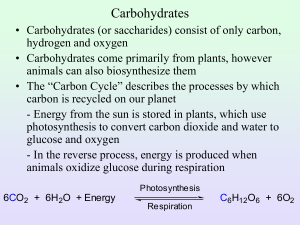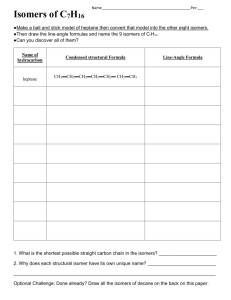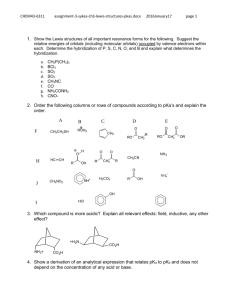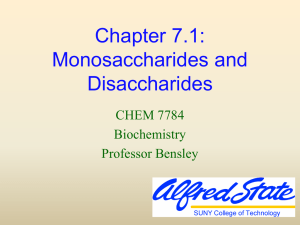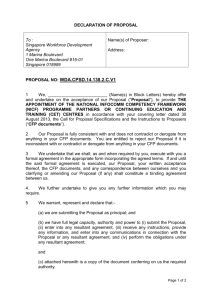Some Properties of Monosaccharides
advertisement
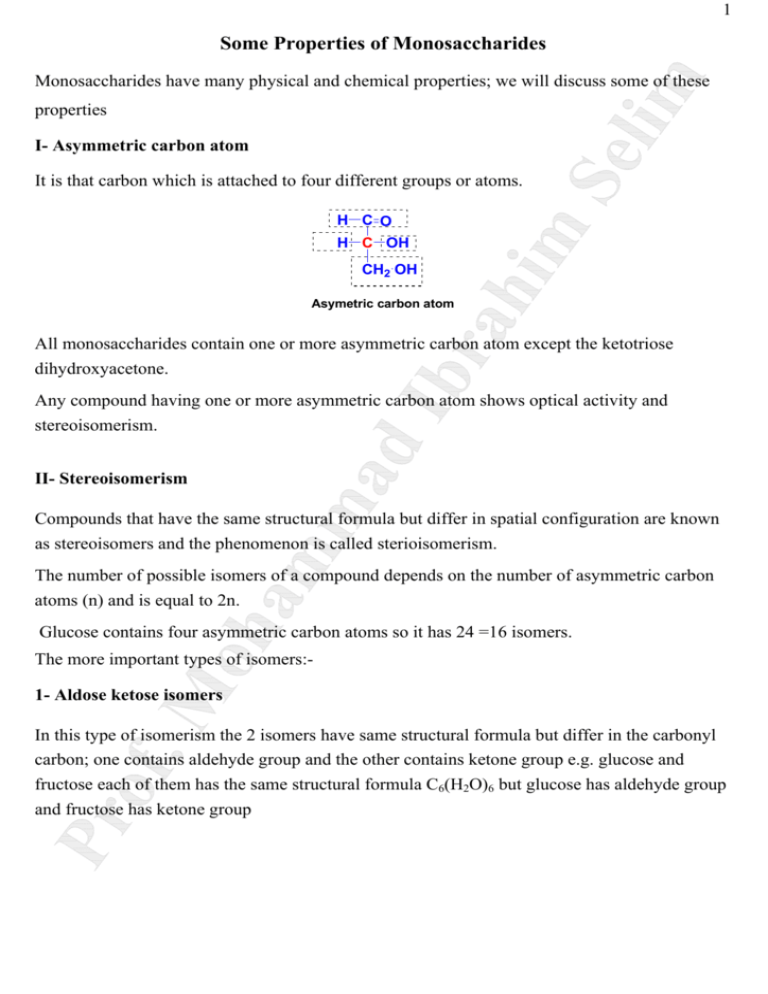
1 Some Properties of Monosaccharides Monosaccharides have many physical and chemical properties; we will discuss some of these properties I- Asymmetric carbon atom It is that carbon which is attached to four different groups or atoms. H C O H C OH CH2 OH Asymetric carbon atom All monosaccharides contain one or more asymmetric carbon atom except the ketotriose dihydroxyacetone. Any compound having one or more asymmetric carbon atom shows optical activity and stereoisomerism. II- Stereoisomerism Compounds that have the same structural formula but differ in spatial configuration are known as stereoisomers and the phenomenon is called sterioisomerism. The number of possible isomers of a compound depends on the number of asymmetric carbon atoms (n) and is equal to 2n. Glucose contains four asymmetric carbon atoms so it has 24 =16 isomers. The more important types of isomers:1- Aldose ketose isomers In this type of isomerism the 2 isomers have same structural formula but differ in the carbonyl carbon; one contains aldehyde group and the other contains ketone group e.g. glucose and fructose each of them has the same structural formula C6(H2O)6 but glucose has aldehyde group and fructose has ketone group 2 CH2 OH H C O H C OH HO C H C O HO C H H C OH H C OH H C OH H C OH CH2 OH glucose (aldohexose) CH2 OH fructose (ketohexose) 2- D and L isomers A monosaccharide can be found either in D form or L form; in D form the hydroxyl group at the penultimate carbon (the carbon before the last carbon) is on the right side while in L form the hydroxyl group at penultimate carbon is on the left side e.g. D-glyceraldehyde and Lglyceraldehyde, also D-glucose and L-glucose. D-sugars are the most abundant forms in humans H C O H C OH HO C H H C O H C OH H C O HO C H CH2 OH CH2 OH D-glyceraldehyde L-glyceraldehyde H C OH H C OH CH2 OH D-glucose H C O H C OH HO C H H C OH HO C H CH2 OH L-glucose 3- Epimers Epimers differ in configuration around one carbon atom other than the carbonyl carbon and the penultimate carbon. Glucose and galactose have the same structural formula C6(H2O)6 but differ only in the position of the hydroxyl group at C4; glucose has hydroxyl group at C4 on the right side while galactose has hydroxyl group at C4 on the left side. So glucose and galactose are C4 epimers Also, glucose and mannose have the same structural formula C6(H2O)6 but differ only in the position of the hydroxyl group at C2; glucose has hydroxyl group at C2 on the right side while mannose has hydroxyl group at C2 on the left side. So glucose and mannose are C2 epimers 3 H C O H C OH 1 H C O HO C H 3 HO C H H C O 2 H C OH HO C H HO C H H 4C OH HO C H H C OH 5 H C OH H C OH H C OH 6CH OH 2 CH2 OH D-glactose CH2 OH D-mannose D-glucose 4- α and β isomers These are monosaccharides that differ in configuration only around the carbonyl carbon in cyclic structure. A monosaccharides in cyclic structure can exist either in α or β configuration. In α form the hydroxyl group attached to the carbonyl carbon is on the right side. In β form the hydroxyl group attached to the carbonyl carbon is on the left side. In monosaccharide solutions, the α and β forms are in equilibrium and can be readily converted to each other. H HO OH C C H C OH H C OH HO C H HO C H H C OH H C OH H C H O CH2 OH α D-glucose H C O CH2 OH β D-glucose III- Optical activity It is the ability of the compound to rotate plane polarized light to the right or to the left Plane polarized light is the light that its waves pass in the same plane by the action of special prisms. If the compound rotates plane polarized light to the right, it is dextrorotatory (d or +). If the compound rotates plane polarized light to the left, it is levorotatory (l or -). The angle of rotation is measured by polarimeter and is affected by many factors such as the source of light, nature and concentration of substance and temperature. 4 Each optically active substance has a specific angle of rotation. For example, the specific rotation for glucose is +52.5 o and for fructose is –91 o. IV- Mutarotation It is the gradual change of rotation observed in freshly prepared solutions of sugars with free aldehyde or ketone groups. Freshly prepared D-glucose solution has an angle of rotation +112o which gradually decreases to become constant at +52.5 o Also freshly prepared D-glucose solution has an angle of rotation +19o which gradually increases to become constant at +52.5 o. Mutarotation results from spontaneous change of α to β forms and vice versa through the straight chain formula. H HO OH H C O H C OH C H C OH HO C H HO C H H C OH H C O CH2 OH α D-glucose + 112o H C H C OH HO C H H C OH H C OH H C OH H C CH2 OH D-glucose (straight chain formula) +52.5o O CH2 OH β D-glucose +19o V- Reducing properties All monosaccharides have reducing property due to presence of free aldehyde or ketone group They reduce Fehling solution giving red precipitate of cuprous oxide
